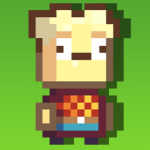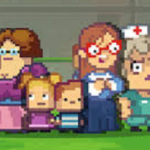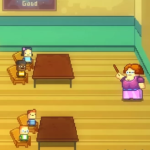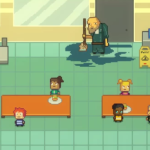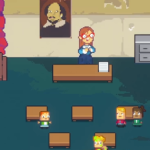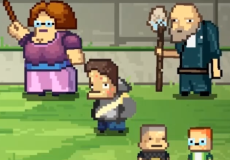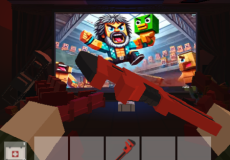

Favourite Games
New Games
Kindergarten 3
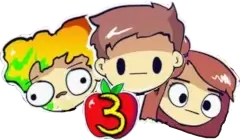
Kindergarten invites players into a deceptively simple school setting where routine and danger exist side by side. On the surface, it appears to be a basic classroom simulator—interact with classmates and faculty, complete tasks, and get through the day. However, what begins as a familiar school day soon twists into something darker, full of mysteries and consequences based on your choices. In this review, we’ll explore the game’s design, gameplay mechanics, characters, quests, and achievements to see how a short, 90-minute experience leaves a lasting impression.
Game Overview
Kindergarten was developed by Ritalin Games and originally released in 2021 as a browser-based pointandclick adventure. It uses pixel-art graphics and retro sound design to craft a lighthearted aesthetic, which the game quickly subverts with a growing sense of unease. As a student at an unnamed kindergarten, you follow a tight schedule, moving between classes, gym, playground, nurse’s office, and the principal’s room. Your objective is to solve a personal puzzle—locating a special lunchbox—while unraveling the bizarre routines and hidden systems within the school.
Gameplay Mechanics
At its core, Kindergarten plays like a visual novel combined with light puzzle elements. Movement occurs through rigid location selection via a schedule interface, and interactions take place through dialogue choices and item use. The success or failure of your day depends on how well you coordinate your actions based on what you’ve learned.
Key gameplay systems include:
- Schedule Management: The day is split into morning, recess, gym, lunch, and afternoon segments. Each period allows for specific interactions and access to locations.
- Item Collection: Players collect small items like snacks, school ID cards, or flowers. These items often unlock interactions with characters or open new paths.
- Dialogue Choices: Conversations offer multiple responses, each with consequences that change character behavior or unlock side tasks.
- Branching Outcomes: Certain actions trigger mission-related sequences. Killing or gagging a character, unlocking secret zones, or failing a mission can end your day immediately.
- Memory-Based Progression: Information gained during failed runs carries forward in the player’s mind, effectively becoming part of the puzzle mechanics without visual representation.
Character Profiles
The school is populated with students, staff, and occasional adults, each with distinct personalities and roles. Some only matter for minor quests, while others tie directly into secret endings.
- Janitor
A key figure in multiple missions. He might be violent, sinister, or oddly approachable depending on your actions. He offers quests like locating his cleaning tools or assisting him with upset students. - Principal
Often locked behind his office door. You need a lunchbox or keycard to access his room. He maintains a strict but unpredictable demeanor, and some paths allow you to confront him directly. - Teacher
Typically found in the classroom giving orders. Your interactions with her can lead to extra tasks or unlock new dialogue sequences, depending on timing. - Frog Girl
A recurring student who loves frogs and will offer your party favors in exchange for careful item use. - Smart Girl
Another student who has quest lines related to school supplies or quiz answers. She may allow access to restricted areas. - Bully
A character who can be confronted, befriended, or manipulated to serve your objectives. - Nurse
Located in the nurse’s office. Interactions can lead to healing another character or gaining items that unlock missions. - Former Principal
An obscure reference, but she may appear in secret content or endings.
These characters make the school feel like a living system, and how they respond depends entirely on the order in which you approach them, the items in your possession, and your dialogue choices.
Quest Types
The quests in Kindergarten are structured around choices that influence the entire school day, with each path unlocking new interactions and consequences. From helping a janitor with suspicious tasks to trading items with classmates for secret information, every objective weaves into the broader mystery of the school. Some quests require you to play the day multiple times just to collect the right combination of dialogue and items, while others hinge on completing optional steps in a specific order. These quests don’t just guide progress—they reveal the dark undercurrents of the school’s routine, encouraging players to experiment and observe every outcome to uncover the full story.
Achievement Guide
Kindergarten tracks progress through achievements, which help motivate replay and experimentation. Notable achievements include:
- Forgotten Lunchbox – Recover your lunchbox by noon without interacting with the frog girl.
- School Hero – Complete a quest chain involving multiple character helpers.
- Chemical Instinct – Trigger a secret ending by interacting with specific switches or vents.
- Ghost in the Hallway – Unlock a rare event practiced through repeated play and optional steps.
- Master Planner – Finish a perfect day: recover the lunchbox, complete all side missions, and leave before the final bell.
These achievements serve as markers of progress and encourage players to revisit earlier decisions. Achievements are stored locally in the save file and carry across browser sessions—important for mobile and desktop players alike.
Kindergarten 2
Kindergarten 2 builds on the twisted foundation of the first game, placing players in a new school filled with strange characters, unpredictable events, and a schedule that resets each day. This sequel expands the gameplay with new locations, like the science lab and teacher’s lounge, while introducing more elaborate storylines that require careful planning and item management. The game challenges players to navigate shifting alliances, complete branching missions, and uncover hidden secrets across multiple playthroughs. With its layered puzzles and dark humor, Kindergarten 2 turns every school day into a strategic, chaotic experience where one wrong move can change everything.
Kindergarten 3
Kindergarten 3 continues the surreal and chaotic journey through a school system where nothing is as it seems, introducing new mechanics, characters, and consequences that expand the bizarre universe even further. This installment raises the stakes by weaving previous storylines into a more complex narrative structure, challenging players to make sense of returning faces, hidden motives, and mysterious events. With new environments to explore and even more unpredictable outcomes tied to every decision, Kindergarten 3 pushes players to think ahead, experiment with combinations of actions, and uncover the truth buried beneath the school’s increasingly unhinged routine.
Final Thoughts
Kindergarten is deceptively light until you realize how much it asks from the player. It uses a short gameplay window and pixel art to construct a world where small actions matter. Success depends not on quick reflexes but on careful notetaking, memory, and willingness to explore dark possibilities.
Discuss Kindergarten 3

